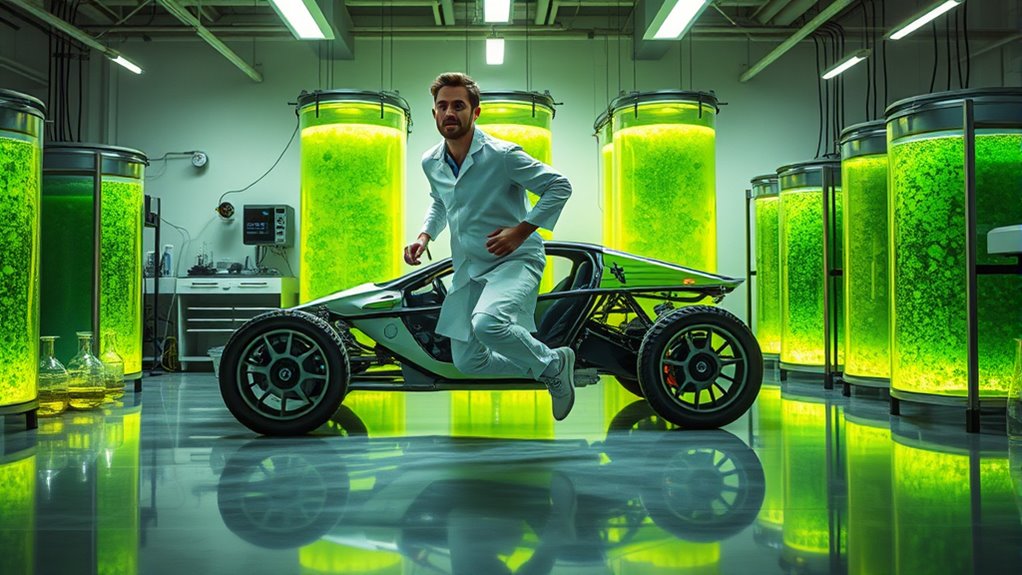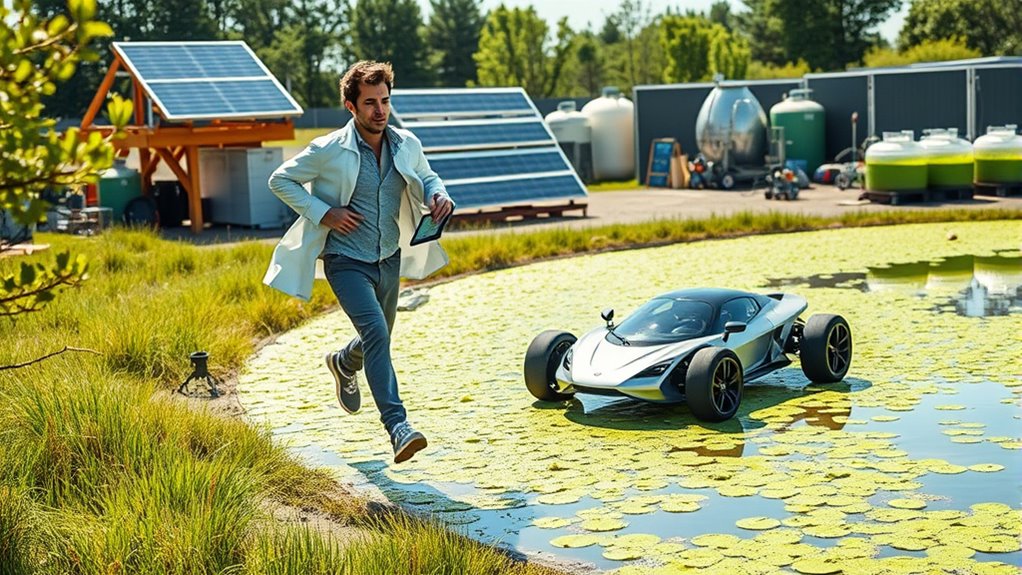Meet Isaac Berzin, a pioneer turning pond scum into fuel for your car. He uses innovative biotech techniques and integrates algae cultivation with power plant emissions, making the process more sustainable and cost-effective. Berzin’s work is part of a larger movement to develop algae-based biofuels that could revolutionize transportation. If you keep exploring, you’ll discover how these innovations could soon power your daily drive using nature’s own algae.
Key Takeaways
- Innovator Isaac Berzin developed algae-based fuel systems using power plant emissions to grow algae sustainably.
- Berzin’s technology converts algae into biodiesel, potentially fueling cars with pond scum.
- His company, GreenFuel Technologies, pioneered large-scale algae cultivation integrated with industrial CO2 sources.
- The approach emphasizes eco-friendly, renewable fuel production from algae, reducing greenhouse gases.
- Berzin’s work is part of efforts to make algae biofuel a viable alternative to traditional fossil fuels.
Early Ideas and Pioneers in Algae Fuel Research

The concept of using algae as a fuel source has roots that date back to the early 1940s, when scientists like Harder and Von Witsch first proposed cultivating microalgae for lipid extraction to produce food or fuel. You might be surprised to learn that early research focused on large-scale algae cultivation, especially within the genus Chlorella, aiming to produce sustainable energy. Post-World War II, efforts expanded across countries like Germany, Japan, and Israel, exploring innovative culturing techniques. Japan’s RITE demonstrated algae growth using flue gas from power plants as a CO2 source in the 1990s, highlighting early environmental integration. These pioneering ideas set the foundation for modern algae biofuel research, emphasizing the potential of microalgae as a renewable energy resource long before commercial viability was achieved.
The US Department of Energy’s Aquatic Species Program

Amid rising oil prices and energy security concerns during the late 1970s, the US Department of Energy launched the Aquatic Species Program in 1978 to explore algae as a viable source of liquid transportation fuel. Over 18 years, the program invested $25 million and demonstrated that large-scale algae production in outdoor ponds was feasible. However, cost barriers prevented competitiveness: unextracted algal oil ranged from $59–186 per barrel, compared to under $20 for petroleum in 1995. The table below highlights key costs and outputs:
| Aspect | Details |
|---|---|
| Investment | $25 million over 18 years |
| Production Feasibility | Large-scale outdoor ponds feasible |
| Cost per Barrel | $59–186 (algal oil) |
| Petroleum Cost (1995) | Under $20 |
| Program Conclusion | Abandoned in 1996 due to costs |
Additionally, the program underscored the importance of advancements in sustainable energy to reduce reliance on fossil fuels.
Greenfuel Technologies: Innovating With Algae and Emissions

Greenfuel Technologies is transforming algae cultivation by using emissions from power plants as a CO2 source, making the process more sustainable. This approach helps reduce greenhouse gases while producing biofuel, aligning environmental benefits with energy needs. By innovating with emissions, you can explore renewable fuel production and cleaner, more efficient ways to generate renewable fuels. Additionally, utilizing airless paint sprayers can streamline the application process in various industrial and maintenance projects, improving efficiency and finish quality. A comprehensive holistic SEO approach can further enhance the visibility of such innovative solutions, attracting more attention from environmentally conscious audiences. Proper signage and awareness of road safety regulations are essential in promoting safe practices related to these technological advancements.
Algae Cultivation From Emissions
Innovative algae cultivation techniques leverage emissions from fossil fuel power plants to produce biofuel, transforming pollutants into valuable resources. By capturing CO2 directly from flue gases, you can accelerate algae growth and reduce greenhouse gases simultaneously. This process not only mitigates pollution but also creates a sustainable feedstock for biofuel production. You might consider integrating algae systems with existing power plants, optimizing gas flow for maximum algae yield. Additionally, using emissions helps lower the overall environmental footprint of energy facilities. The key is designing bioreactors that efficiently utilize flue gases while preventing contamination. This approach turns harmful emissions into a renewable resource, advancing both clean energy initiatives and pollution control efforts. Nanotechnology can also play a role in improving bioreactor materials and process efficiency. Incorporating tableware materials that are eco-friendly and durable can further enhance the sustainability of these systems. Moreover, innovative approaches such as bioengineering can optimize algae strains for faster growth and higher lipid content, making biofuel production more efficient. Implementing monitoring systems for real-time analysis can ensure optimal conditions and maximize yield. Additionally, integrating home decor materials into bioreactor designs could promote eco-friendly aesthetics and community acceptance.
Sustainable Biofuel Innovations
Sustainable biofuel innovations are transforming how we produce renewable energy by harnessing algae and emissions to create cleaner fuels. Companies like GreenFuel Technologies have pioneered systems that grow algae using CO2 emissions from power plants, turning pollutants into valuable resources. These innovations focus on scalable processes that convert algae biomass into biofuels such as biodiesel and ethanol, reducing reliance on fossil fuels. Unlike earlier efforts, modern techniques emphasize cost-efficiency, environmental benefits, and integration with existing energy infrastructure. By leveraging emissions as a feedstock, these methods not only produce renewable fuels but also help lower greenhouse gases. Additionally, advancements in event promotion strategies are crucial for increasing awareness and adoption of algae-based biofuels. As technology advances, algae-based biofuels are becoming a practical, sustainable alternative, promising to reshape the future of clean transportation and energy independence.
Overcoming Technical Challenges and Business Hurdles

Overcoming technical challenges and business hurdles has been a persistent obstacle in advancing algae-based biofuels. You face issues like high production costs, inefficient harvesting methods, and scaling problems that hinder commercial viability. To tackle these, researchers are developing cost-effective harvesting techniques, such as flocculation and advanced centrifugation. Improving algae strains for higher lipid yields and faster growth also remains critical. Additionally, integrating algae cultivation with existing industrial emissions helps reduce costs and emissions simultaneously. You must navigate funding shortages and market competition, which delay widespread adoption. Overcoming these hurdles requires innovation, collaboration, and strategic investment to make algae biofuels a practical, sustainable energy source. Developing scalable solutions is essential to overcoming these persistent challenges, especially as advances in juice extraction techniques can inform more efficient biomass harvesting processes. Furthermore, leveraging digital platforms for collaboration can accelerate research efforts and facilitate the sharing of breakthroughs across the scientific community. Emphasizing the importance of a creative practice mindset, such collaborations can foster innovative approaches to longstanding technical issues. Incorporating advanced fraud detection techniques can also help protect funding sources and partnership agreements from cyber threats, ensuring sustained progress in the field.
The Role of Algae in Sustainable Energy Development

Have you ever considered how algae could transform our approach to clean energy? Algae play a crucial role in sustainable energy development because they grow quickly and efficiently convert sunlight, CO2, and nutrients into biomass. Unlike traditional crops, algae require minimal land and freshwater, making them a highly eco-friendly source. They produce valuable oils that can be refined into biodiesel, jet fuel, and other renewable fuels, reducing dependence on fossil fuels. Algae also absorb carbon dioxide during growth, helping to lower greenhouse gases. This dual benefit of energy generation and environmental remediation makes algae a promising component of sustainable energy strategies. Additionally, understanding how algae contribute to personal growth and development such as fostering innovation and resilience can accelerate the adoption of algae-based solutions. Exploring algae cultivation techniques further enhances our ability to scale up production efficiently. Developing advanced bioreactor systems can optimize growth conditions and maximize output, making algae-based fuels more viable at commercial scales. Innovations in scaling algae production are essential to meet the increasing global energy demands sustainably. Moreover, research into hydrogen energy and its integration with algae-derived fuels could open new avenues for clean energy utilization. As research advances, algae’s potential to provide scalable, renewable fuels becomes more significant, paving the way for cleaner transportation and a healthier planet.
Inventors and Entrepreneurs Driving Modern Biofuel Solutions

You can see how inventors and entrepreneurs are shaping the future of algae-based biofuels through their innovative ideas and startup ventures. Pioneers like Isaac Berzin and GreenFuel Technologies have pushed the boundaries of algae cultivation and processing, turning concepts into real-world solutions. Their efforts build on the work of early figures in biofuel history, driving modern sustainable energy forward. For example, the versatility of Italian cuisine demonstrates how simple ingredients like tomatoes and herbs can be transformed into a variety of delicious dishes, reflecting the innovative spirit seen in biofuel development. Additionally, understanding the role of emotional support in challenging transitions can inspire a resilient mindset for entrepreneurs navigating the complexities of new energy technologies. Developing dynamic communication exercises can further enhance collaboration within teams working on innovative biofuel projects, fostering a more productive environment. Moreover, addressing building regulations related to biofuel infrastructure can streamline implementation and promote wider adoption of algae-based solutions.
Innovators Behind Algae Fuel
Innovators and entrepreneurs have played a pivotal role in advancing algae-based biofuel technology, transforming early scientific concepts into viable energy solutions. These visionaries have pushed the boundaries of research, developing innovative systems to cultivate and extract fuel from algae. Their efforts include creating scalable bioreactors, optimizing algae strains, and integrating emissions for sustainable growth. Their work has often faced hurdles like high costs and technical challenges but continues to inspire progress.
- Isaac Berzin’s GreenFuel Technologies pioneered algae growth using power plant emissions
- Large-scale projects in Arizona demonstrated algae-to-biofuel potential
- Recognition through awards like the 2006 Emissions Energy Project of the Year
- Restructuring efforts highlight ongoing dedication despite financial and operational hurdles
Startup Pioneers in Bioenergy
Modern bioenergy startups are driving the progression from research to commercial-scale solutions by developing innovative technologies that harness algae and other biomass sources. You see entrepreneurs like Isaac Berzin, who founded GreenFuel Technologies, pioneering systems that use emissions from power plants to grow algae efficiently. These pioneers focus on scalable processes, transforming algae into biofuels that could replace traditional fossil fuels. They often collaborate with large energy providers, demonstrating real-world applications, as seen in GreenFuel’s partnership with Arizona Public Service. Despite setbacks like high costs and technical hurdles, their efforts push the industry forward. These innovators are not just experimenting—they’re building the foundation for sustainable energy solutions, making algae-based fuels a viable, eco-friendly alternative for the future.
Historical Figures in Biofuel
Throughout the development of biofuel technology, several key figures have shaped its evolution from early experiments to current sustainable solutions. Samuel Morey created an engine running on ethanol in 1826, demonstrating biofuel’s potential. Rudolph Diesel envisioned his engine powered by peanut oil, pioneering vegetable oil-based fuels. Isaac Berzin’s GreenFuel Technologies advanced algae biofuel, developing systems that use emissions to grow algae efficiently. These innovators laid the groundwork for modern biofuel solutions, inspiring ongoing research and development. Their efforts span from early engine experiments to cutting-edge algae systems, highlighting the continuous pursuit of renewable energy sources.
- Samuel Morey’s ethanol engine (1826)
- Rudolph Diesel’s peanut oil engine
- Isaac Berzin’s algae fuel innovations
- Pioneering experiments fueling today’s biofuel advancements
The Future of Algae-Based Transportation Fuels

As technology advances and concerns about climate change grow, algae-based transportation fuels are poised to play an increasingly important role in sustainable energy. Future developments aim to improve efficiency, reduce costs, and scale production. Breakthroughs in genetically engineered algae could boost lipid yield, making fuel extraction more viable. Large-scale systems will likely integrate CO2 capture from industrial sources, lowering emissions and costs simultaneously. Here’s a glimpse of what’s ahead:
| Innovation | Impact | Timeline |
|---|---|---|
| Genetic optimization | Higher lipid production | Next 5-10 years |
| Automated harvesting | Cost reduction | 3-7 years |
| CO2 capture tech | Emission reductions | 5-15 years |
| Modular bioreactors | Scalability and flexibility | 5-10 years |
| Policy incentives | Accelerate adoption | Immediate to 10 yrs |
How Pond Scum Could Power Tomorrow’s Cars

Could pond scum really power the cars of tomorrow? Absolutely. Advances in algae biofuel technology make it possible to convert pond scum into usable energy sources. By cultivating algae that produce lipids, you can create fuels similar to diesel or biojet fuel. This process not only reduces reliance on fossil fuels but also helps clean polluted water. Researchers are developing scalable systems to harvest algae efficiently, turning vast ponds into fuel factories. The algae extract CO2 from the atmosphere or emissions, making it a carbon-neutral solution. As technology improves, algae-based fuels could become a sustainable alternative for transportation.
- Cultivating algae for high lipid content
- Converting algae into biodiesel or biojet
- Using CO2 from emissions to accelerate growth
- Scaling systems for large-scale fuel production
Frequently Asked Questions
What Are the Environmental Impacts of Large-Scale Algae Biofuel Production?
Large-scale algae biofuel production can reduce greenhouse gases by capturing CO2 emissions from power plants, helping combat climate change. It also has the potential to lower reliance on fossil fuels, decreasing air pollution and environmental degradation. However, it may cause water resource strain, involve energy-intensive harvesting, and lead to habitat disruption if not managed sustainably. Overall, when carefully controlled, algae biofuel offers a cleaner, renewable energy source with significant environmental benefits.
How Cost-Effective Is Algae-Based Fuel Compared to Traditional Gasoline?
Algae-based fuel isn’t cost-effective yet compared to traditional gasoline. You’ll find that producing algae fuel costs markedly more—around $59 to $186 per barrel—while gasoline costs under $20. Despite its potential, large-scale algae biofuel production struggles to compete financially with petroleum due to high cultivation, harvesting, and processing costs. So, unless technology advances or costs drop, algae fuel remains a promising but expensive alternative.
Can Algae Biofuel Be Integrated Into Existing Vehicle Engines?
Yes, algae biofuel can be integrated into existing vehicle engines, but it’s not as simple as pouring it in. You might need modifications or blending with gasoline to guarantee compatibility and peak performance. Researchers are working to develop algae-based fuels that can seamlessly replace or mix with traditional fuels. With continued advancements, you could soon see algae biofuel powering your car without major engine overhauls, making sustainable travel more accessible.
What Are the Key Breakthroughs Needed to Commercialize Algae Fuel Widely?
To commercialize algae fuel widely, you need key breakthroughs in cost reduction, scalable harvesting, and efficient processing. You must develop affordable methods to produce algae oil at large scales, making it competitive with petroleum. Improving harvesting technology to lower costs and increase speed is vital. Additionally, refining conversion processes to maximize yield and quality will help integrate algae fuel seamlessly into existing engines, enabling broader adoption and sustainability.
How Does Algae Cultivation Affect Freshwater and Land Resources?
You should know that algae cultivation can strain freshwater and land resources, especially when scaled up. Large ponds or bioreactors require significant water, which might compete with agriculture or ecosystems. If you choose sustainable practices, like using wastewater or non-arable land, you can reduce environmental impact. However, careful planning and innovative technology are essential to minimize resource consumption and make algae fuel production eco-friendly and viable at a larger scale.
Conclusion
So, next time you see pond scum, remember—it might just be the fuel that powers your car tomorrow. While we chase high-tech solutions and shiny new technologies, the answer could be lurking beneath the surface, proving that sometimes, the simplest ideas are the most revolutionary. Ironically, what we dismiss as waste might become the very energy source that drives our future, reminding us that innovation often starts where we least expect it—that’s nature’s own fuel station.







